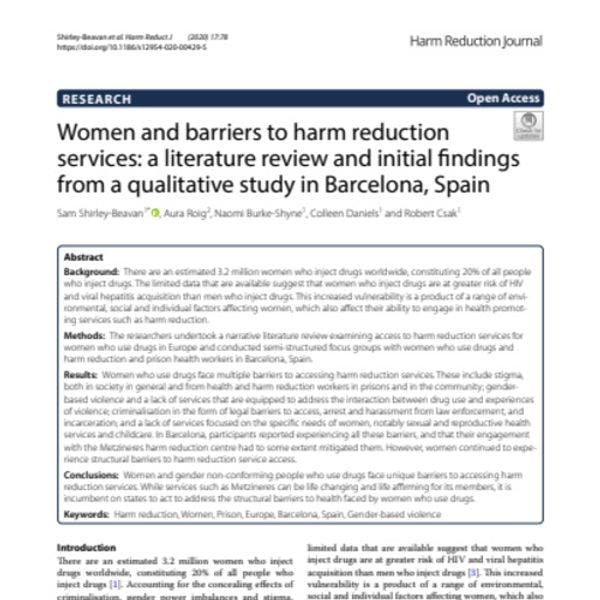HRJ - https://harmreductionjournal.biomedcentral.com/articles/10.1186/s12954-020-00429-5?fbclid=IwAR3lsaO-ifsM6ImrgfvoxMrhmhW-skn05GqO43pj6wII4fYCQNrJgFEaKRs
Mujeres y barreras a los servicios para reducción de daños: Una revisión bibliográfica y hallazgos iniciales de un estudio cualitativo realizado en Barcelona, España.
Shirley-Beavan et al. demuestran cómo las mujeres y las personas que no conforman identidades binarias de género y que consumen drogas, enfrentan obstáculos particulares para acceder a servicios adecuados de salud y reducción de daños. Más información, en inglés, está disponible abajo.
By Sam Shirley, Aura Roig, Naomi Burke-Shyne, Colleen Daniels, and Robert Csak - Harm Reduction Journal
There are an estimated 3.2 million women who inject drugs worldwide, constituting 20% of all people who inject drugs. Accounting for the concealing effects of criminalisation, gender power imbalances and stigma, this number is likely to be an underestimate. The limited data that are available suggest that women who inject drugs are at greater risk of HIV and viral hepatitis acquisition than men who inject drugs. This increased vulnerability is a product of a range of environmental, social and individual factors affecting women, which also affect their ability to engage in health promoting services such as harm reduction.
Health inequities occur where there are preventable differences between groups in access to services and resources that improve health outcomes. Women are demonstrably subject to health inequities with regard to access to harm reduction services. Despite a clear need for harm reduction services for women, they continue to be dominated by “masculinist” concerns and do not meet women’s needs, and the literature indicates that women who use drugs are rarely adequately represented in design and evaluation of harm reduction services.
In Europe, the European Monitoring Centre for Drugs and Drug Addiction (EMCDDA) indicates women make up approximately a quarter of all people with drug dependence and around one-fifth of all entrants to drug treatment in Europe. EMCDDA reports women are particularly likely to experience stigma and economic disadvantage and to have less social support, among other factors.
A number of subgroups of women who use drugs have special needs. These subgroups, which often overlap, include pregnant and parenting women; women involved in sex work, who may often experience violence and stigma; women from ethnic minorities; women who may have been trafficked; and women in prison.
This paper builds on previous literature reviews that have examined the relationship between drug use and HIV among women, treatment effectiveness among women, stigma faced by women who use drugs, and drug use and intimate partner violence. It seeks to build on this body of work by examining the literature on women and harm reduction services globally, with the specific aim of identifying the key barriers standing in the way of women’s access to these services. The paper categorises the key barriers under four intersecting themes: stigma and structural violence, gender-based violence, criminalisation, and a lack of female-specific services, and highlights examples of each from Europe. It further analyses the evidence gathered in a qualitative study in Barcelona to determine to what extent barriers are evident in that context.
Descargas
Temas
Regiones
Perfiles relacionados
- Naomi Burke-Shyne
